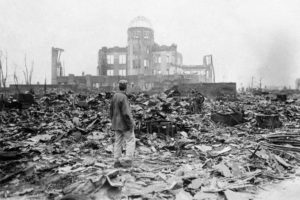The Bombings of Hiroshima and Nagasaki Remembered
At 2:45 in the morning of August 6, 1945, an American B-29 bomber flew north from Tinian Island in the Marianas toward Japan. Three and a half hours later, over the city of Hiroshima, the air craft dropped an 8,900-pound atomic weapon. Two thousand feet above the ground, the bomb, dubbed “Little Boy” by its makers, detonated, leveling almost 90% of the city.

Hiroshima a month after the detonation of the atom bomb.
On August 9, another B-29 set out for the Kokura Arsenal on the southwest Japanese island of Kyushu. Foul weather, however, persuaded the pilot to proceed instead toward Nagasaki. Over this secondary target a larger atomic weapon code-named “Fat Man.” was dropped. Local geography spared Nagasaki from the near total devastation suffered by Hiroshima; only one third of the city was destroyed.
The attacks on Hiroshima and Nagasaki had a devastating psychological impact on the already weakened Japanese. Emperor Hirohito accepted the U.S.’ terms of surrender on August 14.
The Controversy
The decision to bomb Hiroshima and Nagasaki—the first and last use of atomic weapons in combat—remains one of the most controversial in military history. Why did the US bomb Japan? There is no clear explanation. The U.S. military officials probably believed that it was necessary to force an unconditional Japanese surrender. Others suggest that US President Truman, fearing a Soviet attempt to dominate the postwar Asian order, ordered the bombing to force Japan’s surrender before Russia had the chance to enter the fray. Truman may also have wanted to intimidate his potential rival Stalin with the United States’ new destructive capability. Yet another explanation is that the US wanted to test the destructive capability of its nuclear weapons.
Whether the bombings were justified or not will never be certain. Those who made the decision, as well as most of the survivors, are long gone. The effects, however, remain. One can only hope that those who now wield the tools of mass destruction will remember the lessons of Hiroshima and Nagasaki for a long time to come.